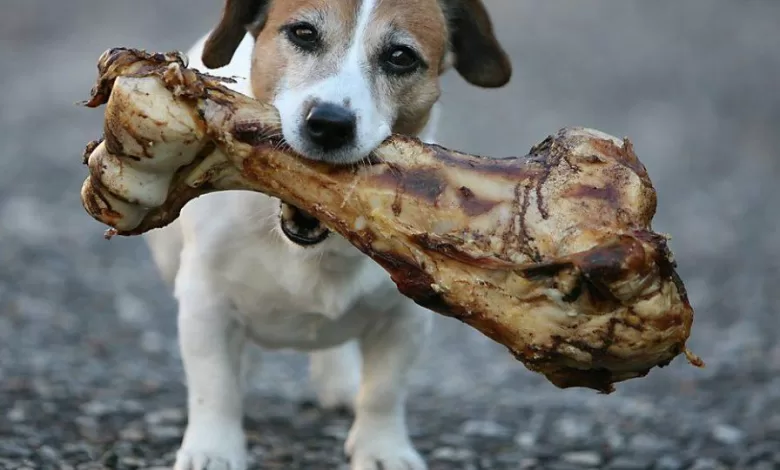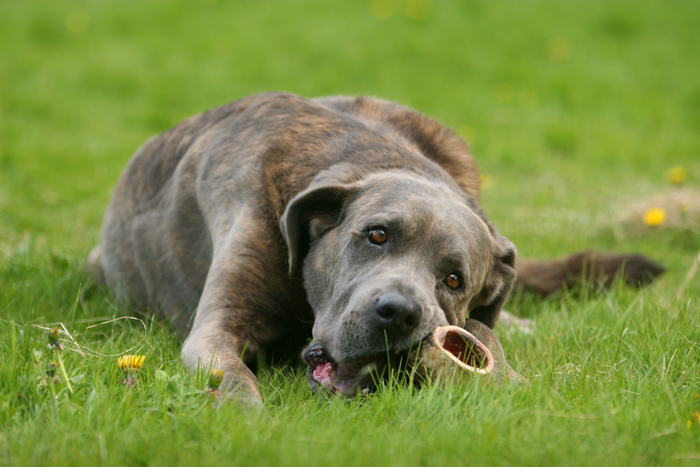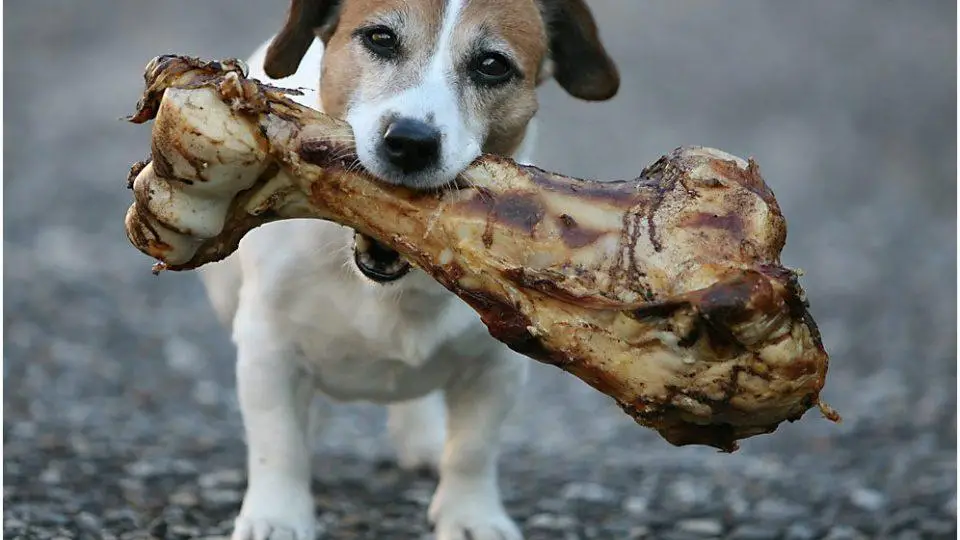Uncovering the Age-Old Tale of the Dog and His Bone

As pet owners, we’ve all witnessed it – our beloved furry friends fiercely guarding their bones as if they were the most precious possessions in the world. But have you ever stopped to wonder why dogs are so protective of their bones? What is the true story behind the age-old tale of the dog and his bone?
In this blog post, we will delve into the fascinating relationship between dogs and bones, exploring the origins of this behavior and looking at its role in canine behavior, health, and training. By the end, you’ll have a better understanding of your dog’s instinct to protect their bones and how to properly handle and interact with them.
The Origins of the Dog and His Bone
The bond between humans and dogs can be traced back thousands of years, with evidence of domesticated dogs dating back to around 15,000 years ago. During this time, dogs have evolved alongside humans, adapting to our living habits and becoming an integral part of our lives.
One of the earliest roles of dogs was as hunters, assisting humans in tracking and capturing prey. This required strength, agility, and sharp teeth – traits that are still present in modern-day dogs. However, dogs didn’t always have access to a steady source of food, and they had to rely on scavenging for survival. This is where the story of the dog and his bone begins.
In ancient times, dogs would come across discarded bones from carcasses left behind by larger predators. These bones were a valuable source of nutrition and played a crucial role in a dog’s diet. As such, dogs would feel the need to protect these bones from other animals who might try to steal them.
The Evolution of the Dog’s Instinct to Protect Its Bone
The need for survival and the importance of bones in a dog’s diet have ingrained the instinct to protect their bones in dogs’ behavior. This innate behavior is also seen in other wild animals, such as wolves, who share a common ancestor with domesticated dogs.
According to animal behaviorists, this behavior can be traced back to the hierarchy in wolf packs. The alpha wolves would have first access to the prey and its bones, and the rest of the pack would then have to fight for their share. This need to protect their food and resources has carried over into modern-day dogs, even though they now have a steady source of food provided by their owners.
This instinct to protect their bones can also be linked to the fact that dogs are natural scavengers. They are always on the lookout for food, and when they come across a bone, they see it as a valuable resource to be protected and guarded.
Why Dogs Are So Protective of Their Bones
Now that we understand the origins of this behavior, let’s explore why dogs are so protective of their bones. While it may seem like just a quirky habit, there are several reasons behind this behavior.
Territorial Instincts
Dogs are territorial creatures, and they see their immediate environment, including their food and possessions, as their territory. In the wild, wolves and other canine species would mark their territory with urine or feces to ward off other animals. Similarly, dogs view their bones as part of their territory and will use various tactics to keep them safe from others.
Resource Guarding
As mentioned earlier, bones were a valuable source of nutrition for dogs in ancient times. This need to protect their food and resources has been passed down through generations and is ingrained in their behavior. This resource guarding behavior can extend beyond bones to other items such as toys, food bowls, and even people.
A Sense of Ownership
Dogs are intelligent creatures and can develop a sense of ownership towards their belongings. When a dog is given a bone, they see it as something specifically given to them and will feel the need to protect it. This behavior is more pronounced in single-dog households where there is no competition for resources.
The Fascinating Relationship Between Dogs and Bones
The relationship between dogs and bones goes beyond just a means of survival. For dogs, bones hold significant emotional and psychological value, making them an essential part of their life.
Chewing as a Natural Behavior
Dogs are natural chewers, and chewing on bones satisfies this instinctive behavior. It also has several physical benefits, such as keeping their teeth clean and strong, reducing stress and anxiety, and providing mental stimulation.
Chewing on bones also helps relieve boredom, which can lead to destructive behaviors in dogs. By giving your dog a bone to chew on, you are providing them with a healthy outlet for their natural chewing tendencies.
A Source of Comfort
For many dogs, their bones act as a source of comfort, much like a security blanket for a child. The simple act of chewing on a favorite bone can help relieve stress and anxiety in dogs, particularly when they are left alone or in unfamiliar environments.
Additionally, the action of chewing releases endorphins in dogs, which have a calming effect, helping them relax and feel content. So while your dog may seem overly protective of their bone, know that it brings them a sense of comfort and security.
A Symbol of Bonding
In some cases, dogs may also see their bones as a symbol of bonding with their owners. By giving them a bone, we are providing them with something of value and showing our love and care for them. In return, dogs will protect their bones as a way of showing their appreciation and loyalty to us.
An Exploration of Canine Behavior: The Dog and His Bone
Now that we’ve uncovered the origins and reasons behind a dog’s instinct to protect their bone, let’s take a closer look at this behavior and its role in canine behavior.
Protective Behaviors
As pet owners, we’ve all experienced the frustration of trying to take something away from our dog, only to have them growl or snap at us. This is their natural protective instinct kicking in, as they see their bone as a valuable possession that needs to be safeguarded at all costs.
This behavior can also manifest as resource guarding, where dogs will aggressively protect their bones from other animals or even humans. In some cases, resource guarding can become a serious issue and may require professional training to overcome.
Hoarding Behavior
Hoarding behavior is also commonly seen in dogs when it comes to their bones. They will often bury them in various places around the house or yard, mimicking the behavior of their wild ancestors who would stash food for times of scarcity.
While this behavior may seem odd to us, it is perfectly normal for dogs and should not be discouraged. However, if your dog is hoarding bones excessively or in inappropriate places, it may indicate underlying anxiety or stress, and consulting with a veterinarian or behaviorist may be necessary.
Understanding the Evolution of the Dog’s Instinct to Protect Its Bone
The evolution of the dog’s instinct to protect their bone has been a crucial factor in their survival and adaptation as domesticated animals. However, as pet owners, we must understand and manage this behavior to ensure the safety of both our dogs and ourselves.
Training and Socialization
Proper training and socialization are key in managing a dog’s protective behavior. From an early age, puppies should be exposed to various situations, including interacting with other dogs and people, so they learn to feel comfortable and secure around others.
Training your dog to “drop” or “leave” their bones on command can also help prevent potential conflicts and keep your dog safe in potentially dangerous situations.
Respect Your Dog’s Space
It’s essential to respect your dog’s space when they are enjoying their bone. Avoid disturbing or trying to take their bone away from them, as this can lead to defensive behavior. Instead, allow them to enjoy their bone in peace and wait until they are done before interacting with them.
Supervision is Key
Lastly, it’s crucial to supervise your dog when they are chewing on a bone, especially if you have multiple dogs. While most dogs will peacefully coexist, there may be instances where fights break out over bones, leading to injuries. By supervising and intervening when necessary, you can prevent potential conflicts and keep your dogs safe.
How Thunder Dog Rescue is Making a Difference for Forgotten Canines
The Importance of Bones in a Dog’s Diet and Health
Aside from their emotional significance, bones play an important role in a dog’s diet and overall health. From keeping their teeth clean to providing essential nutrients, bones are a valuable addition to a dog’s diet.
Dental Health
Regularly chewing on bones helps keep a dog’s teeth clean by removing plaque and tartar buildup. This is particularly crucial for older dogs who may have dental issues and need extra help in maintaining healthy teeth and gums.
However, not all bones are suitable for chewing, and it’s important to choose the right type of bone for your dog. Large, weight-bearing bones, such as beef femurs and large knucklebones, are ideal for cleaning teeth, while smaller bones, such as chicken bones, can splinter and cause harm.
Nutritional Benefits
Bones are a rich source of essential nutrients, including calcium, phosphorus, and magnesium, which are vital for healthy bone growth and development. These minerals are also beneficial for other areas of a dog’s health, such as muscle function and immune system support.
Feeding your dog raw bones is a great way to supplement their diet and provide them with these essential nutrients. However, it’s important to consult with your veterinarian before incorporating bones into your dog’s diet, as they may have specific dietary requirements or health issues that need to be considered.
How Bones Play a Role in Training and Bonding with Your Dog
Training and bonding with your dog is an essential part of being a pet owner, and bones can play a significant role in both these areas. Here’s how:
Training Tool
As mentioned earlier, teaching your dog to “drop” or “leave” their bones on command can be beneficial in preventing potential conflicts and keeping them safe. This command can also be used in other situations, such as when your dog has picked up something dangerous or inappropriate.
Bonding and Positive Reinforcement
Giving your dog a bone to chew on can also be an act of bonding and positive reinforcement. By rewarding them with a bone for good behavior, you are reinforcing the desired behavior, making it more likely to occur in the future.
Sharing a bone with your dog can also be a fun and interactive way to bond with them. As they chew on their bone, you can stroke and talk to them, strengthening your bond and showing them love and affection.
The Myth of the Dog and His Bone: Separating Fact from Fiction
The tale of the dog and his bone has been passed down through generations, and while there is some truth to it, there are also many myths surrounding this behavior.
Dogs are Greedy
One of the most common misconceptions is that dogs are greedy creatures who will do whatever it takes to get what they want. However, this couldn’t be further from the truth. Dogs have evolved to be social animals who are incredibly attuned to human emotions and desires. If a dog sees that you value something, such as a bone, they will see it as valuable and place a higher importance on it.
Chewing on Bones Causes Aggression
Another myth is that chewing on bones causes aggression in dogs. While it’s true that resource guarding behavior can escalate into aggressive behavior, chewing on bones alone does not cause aggression. This behavior is a natural instinct in dogs and is simply a way for them to protect their resources.
Emotional Rescue: A Stranded Dog’s Journey on a Frozen River Warms Hearts Worldwide. 0long
The Psychological and Emotional Significance of Bones for Dogs
As we’ve explored throughout this blog post, bones hold significant psychological and emotional value for dogs. From providing comfort and stress relief to fulfilling their natural instincts, bones play a crucial role in a dog’s life.
A Sense of Security
For many dogs, bones act as a source of security, providing them with something familiar and comforting. This is especially important for dogs who may suffer from separation anxiety or other forms of stress.
Provides Mental Stimulation
Chewing on bones also provides mental stimulation for dogs, keeping them entertained and engaged. This is particularly beneficial for high-energy breeds who need an outlet for their energy and intelligence.
Bones can also be used as a form of enrichment for dogs, providing physical and mental challenges as they try to access the meat and marrow inside.
A Comforting Routine
For some dogs, their bone-chewing routine becomes a daily ritual, providing them with a sense of comfort and routine. This can be especially helpful for older dogs who may have mobility issues or other health problems and need a structured routine to feel secure.
Tips for Properly Handling and Interacting with Your Dog’s Bones
Now that we’ve explored all the different aspects of the dog and his bone, here are some tips for properly handling and interacting with your dog’s bones:
- Choose the right type of bone – opt for large, weight-bearing bones for dental health and avoid small bones that can splinter.
- Supervise your dog when they are chewing on a bone, especially if there are multiple dogs around.
- Train your dog to “drop” or “leave” their bones on command to prevent potential conflicts.
- Respect your dog’s space when they are enjoying their bone.
- Consider incorporating bones into your dog’s diet as a source of essential nutrients, but consult with your veterinarian first.
- Use bones as a training tool and a way to bond with your dog.
- Don’t buy into the myth that dogs are greedy or that bones cause aggression – understand and manage your dog’s natural instincts instead.
Conclusion
The story of the dog and his bone is an age-old tale that has been passed down through generations. Through this blog post, we’ve uncovered the true origins of this behavior and explored its role in canine behavior, health, and training.
We’ve learned that the need for survival and the importance of bones in a dog’s diet have ingrained the instinct to protect their bones in dogs’ behavior. This behavior is perfectly natural and should be managed and understood by pet owners to ensure the safety and well-being of both their dogs and themselves.
So the next time you see your furry friend fiercely guarding their bone, know that it’s not just a quirky habit – it’s a vital part of who they are as dogs.
Discover the Adorable Tale of the Pitbull Toy Story – A Must-Read for Canine Enthusiasts

















